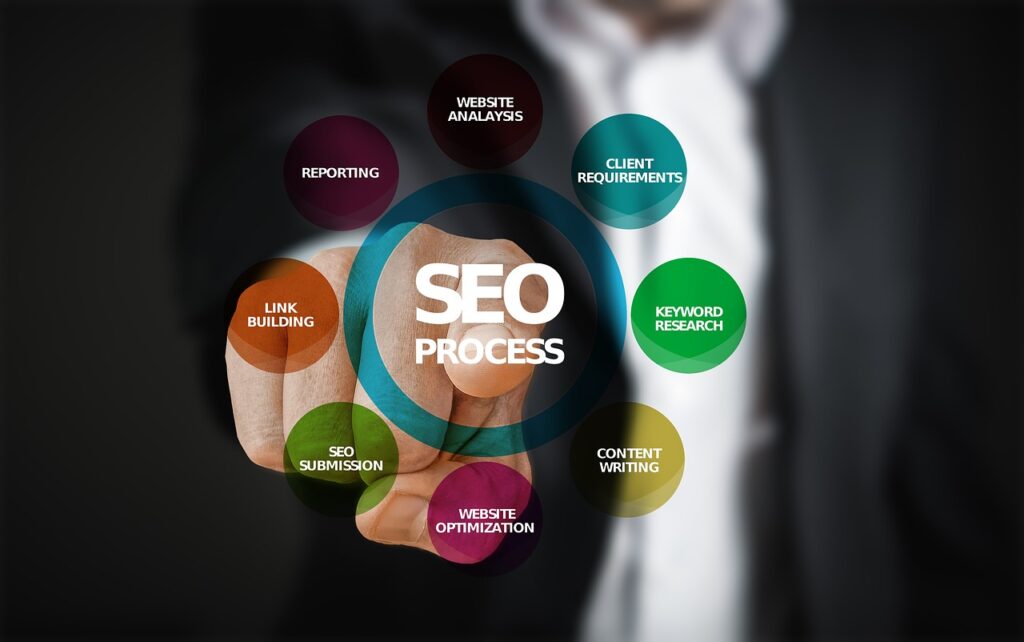Table of Contents
What Is SEO?
Search Engine Optimization (SEO) is the practice of enhancing a website’s visibility in organic (non‑paid) search engine results by helping search engines understand your content and users find your site when they search for relevant queries.
It encompasses optimizing content, HTML elements, and site architecture to align with search engine algorithms and user intent Unlike paid ads, which you buy placement for, SEO “earns” rankings by demonstrating relevance, authority, and a positive user experience
Why SEO Matters
Organic search drives the majority of web traffic—over 53.3% of all site visits globally—compared to just 27% from paid search.
A robust SEO strategy:
-
Delivers sustainable traffic without ongoing ad spend
-
Establishes trust and credibility, as top organic results are perceived as more authoritative
-
Offers compounding ROI, where content improvements and backlinks build value over time.
High organic visibility also supports brand awareness, lead generation, and long‑term business growth, making SEO a cornerstone of digital marketing.
What is SEO and How it Works
Search engines operate in three phases—crawling, indexing, and ranking—each critical to how your site appears in search results.
Crawling
Crawlers (or spiders) discover pages by following links and sitemaps, scanning your site’s structure and content.
Indexing
Once crawled, pages are parsed and stored in a massive database, where search engines analyze text, metadata, images, and other signals like page speed and mobile responsiveness.
Ranking
When users search, engines evaluate indexed pages against hundreds of ranking factors—relevance, authority (backlinks), user engagement, and technical performance—to determine result order
Understanding these processes lets you tailor optimizations to each stage, ensuring crawlers can access your content, index it correctly, and rank it prominently.
The Three Pillars of SEO
On‑Page SEO
On‑page SEO optimizes content and HTML elements to match searcher intent:
-
Title Tags & Meta Descriptions: Craft unique, keyword‑rich titles (50–60 characters) and compelling meta descriptions (150–160 characters) to improve click‑through rates
-
Header Tags (H1–H6): Use clear hierarchy—one H1 per page, followed by H2s and H3s—to structure content for users and crawlers
-
Content Quality & Keywords: Produce in‑depth, original content around primary and related keywords, matching user intent (informational, transactional, navigational)
-
Image Optimization: Compress images, use descriptive filenames, and add keyword‑rich alt text to boost accessibility and SEO
Technical SEO
Technical SEO ensures your site is crawlable, indexable, and performant:
-
Site Speed: Fast loading times are a ranking factor; use Google PageSpeed Insights to identify and resolve performance issues
-
Mobile‑First Design: With mobile‑first indexing, prioritize responsive layouts and touch‑friendly elements
-
XML Sitemaps & Robots.txt: Submit sitemaps and configure robots.txt to guide crawlers to important content and block irrelevant pages
-
Structured Data (Schema): Implement schema markup (e.g., articles, products, events) to enable rich snippets and enhance click‑through rates
Off‑Page SEO
Off‑page SEO builds website authority through external signals:
-
Link Building: Acquire high‑quality backlinks from reputable sites via guest posts, partnerships, and digital PR to boost authority.
-
Brand Mentions & Social Signals: While not direct ranking factors, social engagement and unlinked brand mentions can drive referral traffic and eventual links
-
Influencer & Partnership Outreach: Collaborate with industry influencers and complementary brands to expand reach and earn referrals
Keyword Research Fundamentals
Keyword research identifies the queries your audience uses and informs content strategy:
-
Seed Keywords: Brainstorm core topics based on your products or services.
-
Keyword Tools: Use Ahrefs, SEMrush, or Google Keyword Planner to discover related long‑tail keywords, search volume, and difficulty.
-
Competitor Analysis: Analyze competitors’ top keywords and content gaps to uncover opportunities.
-
Prioritization: Balance high‑volume, competitive terms with lower‑difficulty, high‑intent keywords to achieve quick wins and long‑term growth.
Document your keyword map in a spreadsheet and align it with specific page intents—blog posts for informational queries, product pages for transactional queries—to ensure targeted optimization.
What is SEO Measuring Success
Tracking the right metrics lets you refine your strategy:
-
Organic Traffic: Monitor sessions from search engines in Google Analytics.
-
Keyword Rankings: Use rank‑tracking tools to measure position changes for target keywords.
-
Click‑Through Rate (CTR): Analyze impressions vs. clicks in Google Search Console to improve titles and meta descriptions.
-
Backlink Profile: Audit link volume and quality in Ahrefs or SEMrush to ensure healthy authority growth.
-
Engagement Metrics: Bounce rate, time on page, and pages per session reveal content relevance and user experience.
Regularly review these KPIs to identify underperforming pages for optimization and scale successful tactics across your site.
What is SEO Best Practices
-
Focus on User Intent: Always satisfy the searcher’s need—informational, navigational, or transactional—to earn and retain rankings.
-
Maintain Logical Site Structure: Use silos and clear navigation to group related topics and enable deep linking.
-
Publish & Update Content: Regularly add fresh posts and refresh evergreen pages to signal relevancy.
-
Secure Site (HTTPS): A secure connection is a lightweight ranking factor and builds user trust.
-
Optimize for Rich Results: Leverage schema markup and structured data to qualify for featured snippets, knowledge panels, and other enhanced listings.
What is SEO Common Mistakes to Avoid
-
Keyword Stuffing: Overloading content with keywords diminishes readability and can trigger penalties.
-
Ignoring Mobile Users: Failing to optimize for mobile interfaces leads to poor UX and ranking drops under mobile‑first indexing.
-
Relying on Low‑Quality Links: Spammy backlinks harm your site’s authority; focus on relevance and trustworthiness.
-
Thin or Duplicate Content: Pages with scant or copied information confuse search engines and dilute authority.
-
Neglecting Page Speed: Slow pages frustrate users and are penalized in ranking algorithms.
What is SEO Keeping Up with Algorithm Updates
Google releases core, product review, and page experience updates multiple times a year, impacting ranking factors like E‑A‑T (Expertise, Authority, Trust) and Core Web Vital
-
Monitor Official Channels: Follow the Google Search Central Blog for release notes.
-
Audit Impacted Pages: After major updates, review rankings and traffic dips in Search Console.
-
Adapt Quickly: Refine underperforming content by enhancing depth, adding multimedia, or improving UX.
Staying informed and agile helps you maintain and regain visibility when search algorithms shift.
Conclusion
SEO is an ongoing, multi‑faceted discipline that blends technical know‑how, content strategy, and authority building to align with search engines and user needs.
By mastering crawling, indexing, and ranking mechanics, deploying on‑page, technical, and off‑page tactics, conducting thorough keyword research, tracking performance metrics, and adhering to best practices—while avoiding common mistakes—you’ll unlock sustainable organic growth and amplify your brand’s online presence.
Ready to dominate search engine rankings and drive qualified traffic to your site? Check out how Jude transformed his life From being a Bus Conductor in a “pure water” factory to a Top-Rated Writer using this step by step SEO Income Puller
Discover our full range of SEO and digital marketing services at DigitalMarketingKitz.com/services or book a free consultation to craft a tailored SEO roadmap for your business!



